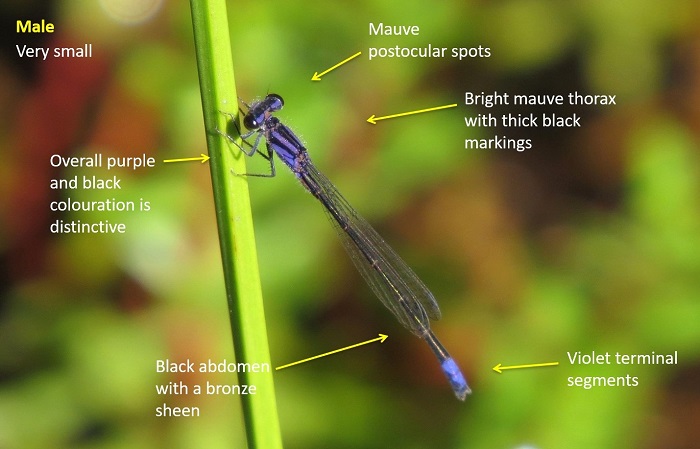Cover photo by Gregg Darling.
Find the Mauve Bluet in the FBIS database (Freshwater Biodiversity Information System) here.
Family Coenagrionidae
Identification
Very small
Length up to 23mm; Wingspan reaches 34mm.
The adult male is highly distinctive, being bright mauve/violet and black. The black parts have a bronze-green gloss.
The female is mainly pale brown with darker markings.
Male Mauve Bluets are most likely to be mistaken for the Male Spesbona (Spesbona angusta). Both show violet and black colouration, but the Spesbona is larger and more robust. The head of the Spesbona is violet with black postocular markings, while the head of the Mauve Bluet is black with purple postocular markings.
Female Mauve Bluets could easily be mistaken for those of the Swamp Bluet (Africallagma glaucum) and are best identified by their association with the males.
Click here for more details on identification.

Theewaterskloof, Western Cape
Photo by Felicity Grundlingh
Habitat
The preferred habitat of the Mauve Bluet is transient pools in stream beds with floating vegetation and dense reeds and sedges.
Behaviour
The Mauve Bluet is a rather inconspicuous species that sits low down among dense waterside vegetation. It is usually only spotted once it flits away after being disturbed.
The Mauve Bluet is most active from October to December (see Phenology below).
Status and Conservation
The Mauve Bluet is rare and highly localised. It’s habitat is threatened by the encroachment of cattle and the loss of suitable habitat. For these reasons, the International Union for Conservation of Nature (IUCN) has listed it as endangered.
Distribution
The Mauve Bluet is endemic to a few small, seemingly isolated areas of the Western Cape Province in South Africa. However, due to its cryptic behaviour and small size, the Mauve Bluet is probably under-recorded and is likely to occur at other sites.
Below is a map showing the distribution of records for Mauve Bluet in the OdonataMAP database as at February 2020.

Below is a map showing the distribution of records for Mauve Bluet in the OdonataMAP database as of December 2024.

The next map below is an imputed map, produced by an interpolation algorithm, which attempts to generate a full distribution map from the partial information in the map above. This map will be improved by the submission of records to the OdonataMAP section of the Virtual Museum.


Ultimately, we will produce a series of maps for all the odonata species in the region. The current algorithm is a new algorithm. The objective is mainly to produce “smoothed” maps that could go into a field guide for odonata. This basic version of the algorithm (as mapped above) does not make use of “explanatory variables” (e.g. altitude, terrain roughness, presence of freshwater — we will be producing maps that take these variables into account soon). Currently, it only makes use of the OdonataMAP records for the species being mapped, as well as all the other records of all other species. The basic maps are “optimistic” and will generally show ranges to be larger than what they probably are.
These maps use the data in the OdonataMAP section of the Virtual Museum, and also the database assembled by the previous JRS funded project, which was led by Professor Michael Samways and Dr KD Dijkstra.
Phenology


Further Resources
The use of photographs by Gregg Darling and Felicity Grundlingh is acknowledged.
Mauve Bluet Proischnura polychromatica (Barnard, 1937)
Other common names: Persbloutjie (Afrikaans)
Recommended citation format: Loftie-Eaton M; Navarro R; Tippett RM; Underhill L. 2025. Mauve Bluet Proischnura polychromatica. Biodiversity and Development Institute. Available online at https://thebdi.org/2020/05/12/mauve-bluet-proischnura-polychromatica/
References: Tarboton, M; Tarboton, W. (2019). A Guide to the Dragonflies & Damselflies of South Africa. Struik Nature.
Samways, MJ. (2008). Dragonflies and Damselflies of South Africa. Pensoft
Samways, MJ. (2016). Manual of Freshwater Assessment for South Africa: Dragonfly Biotic Index. Suricata 2. South African National Biodiversity Institute, Pretoria

